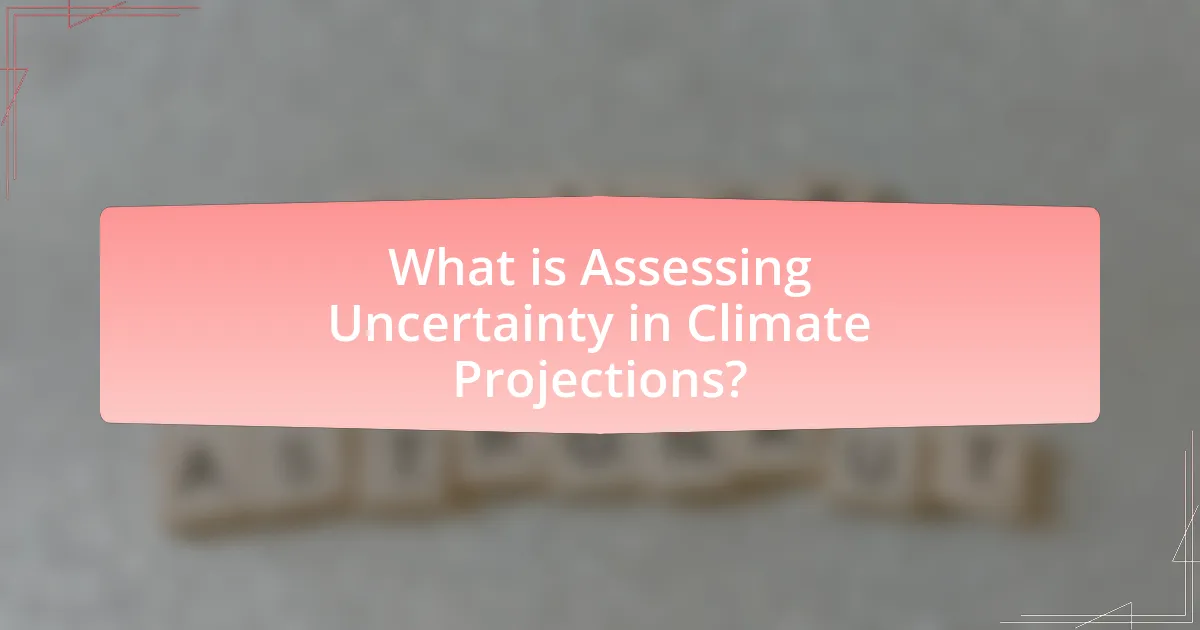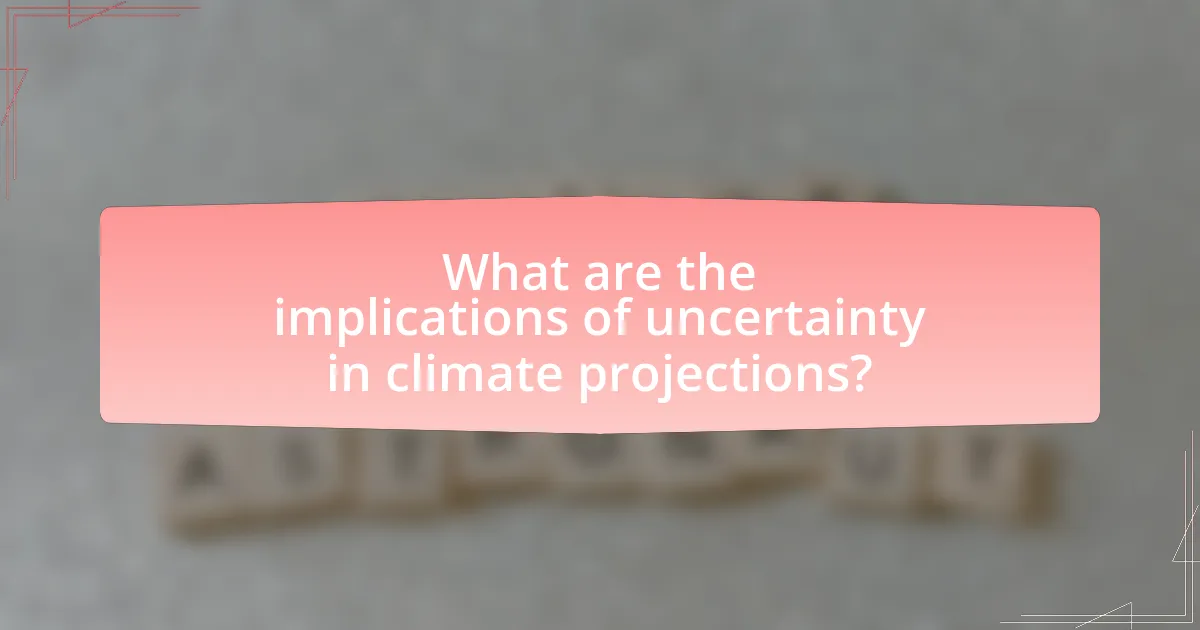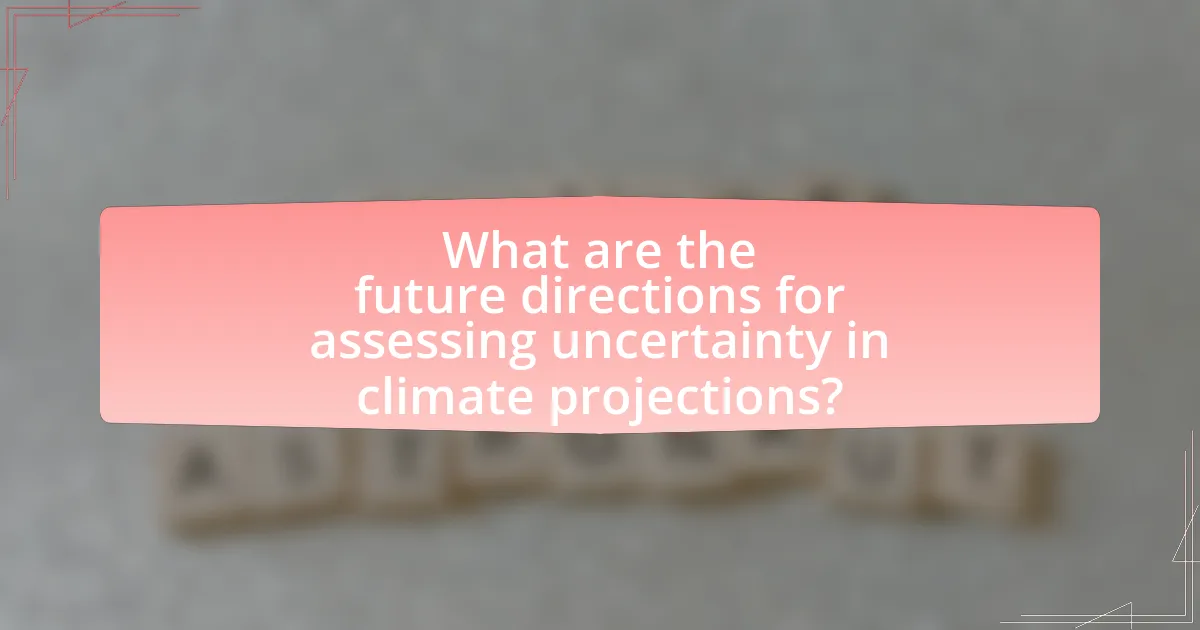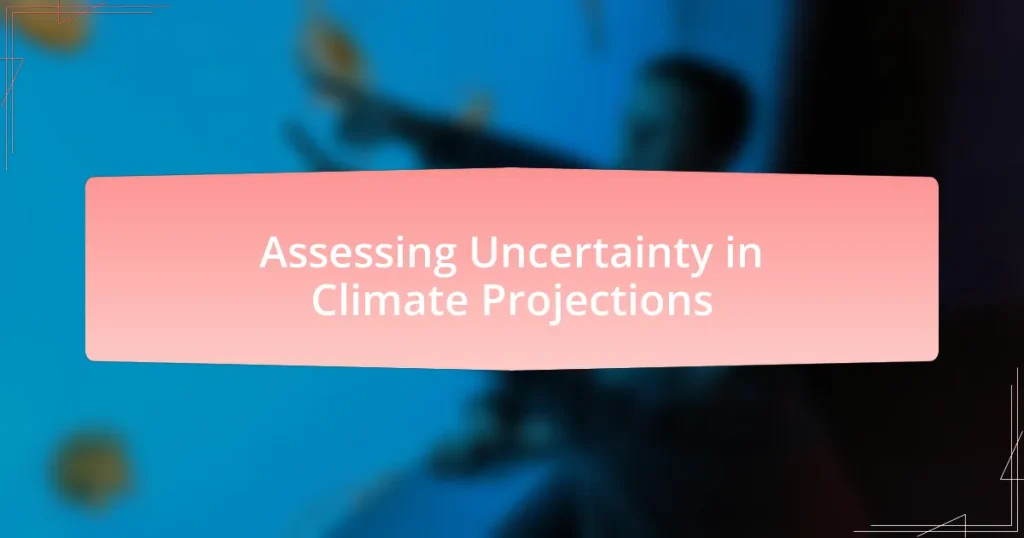Assessing uncertainty in climate projections is a critical process that evaluates the range of possible outcomes and the confidence in those outcomes, influenced by factors such as model limitations, data quality, and natural variability. This assessment is essential for informing policymakers and scientists about the potential impacts of climate change, enabling them to develop effective adaptation and mitigation strategies. The article discusses the importance of quantifying uncertainty, the consequences of ignoring it, the main sources of uncertainty, and the methodologies used to assess and communicate these uncertainties. It also highlights the implications for decision-making in climate policy and the role of stakeholder engagement in addressing uncertainty.

What is Assessing Uncertainty in Climate Projections?
Assessing uncertainty in climate projections involves evaluating the range of possible outcomes and the confidence in those outcomes due to various factors such as model limitations, data quality, and inherent variability in climate systems. This assessment is crucial for understanding the reliability of climate forecasts, as it helps policymakers and scientists gauge the potential impacts of climate change and make informed decisions. For instance, the Intergovernmental Panel on Climate Change (IPCC) emphasizes the importance of quantifying uncertainty to improve the robustness of climate models and projections, thereby enhancing the effectiveness of climate adaptation and mitigation strategies.
Why is assessing uncertainty important in climate projections?
Assessing uncertainty is crucial in climate projections because it helps identify the range of possible future climate scenarios and their associated impacts. By quantifying uncertainty, scientists can better understand the limitations of their models and the variability in climate responses, which is essential for effective decision-making and risk management. For instance, the Intergovernmental Panel on Climate Change (IPCC) emphasizes that acknowledging uncertainties allows policymakers to develop more robust adaptation and mitigation strategies, ultimately leading to more resilient communities in the face of climate change.
What are the potential consequences of ignoring uncertainty in climate models?
Ignoring uncertainty in climate models can lead to significant miscalculations in climate policy and adaptation strategies. When decision-makers rely on overly confident projections, they may underestimate the risks of extreme weather events, sea-level rise, and ecosystem disruptions. For instance, the Intergovernmental Panel on Climate Change (IPCC) emphasizes that failing to account for uncertainty can result in inadequate preparation for climate impacts, potentially costing economies billions in damages and lost productivity. Furthermore, ignoring uncertainty can erode public trust in scientific assessments, as stakeholders may perceive discrepancies between predicted and actual outcomes. This can hinder collaborative efforts to address climate change effectively.
How does uncertainty impact decision-making in climate policy?
Uncertainty significantly impacts decision-making in climate policy by complicating the assessment of risks and potential outcomes. Policymakers often face challenges in predicting climate change effects due to variable data and models, leading to hesitation in implementing necessary measures. For instance, the Intergovernmental Panel on Climate Change (IPCC) reports highlight that uncertainty in climate projections can result in a range of possible future scenarios, which may cause policymakers to delay action or adopt less ambitious targets. This indecision can exacerbate climate-related risks, as seen in the delayed responses to extreme weather events linked to climate change.
What are the main sources of uncertainty in climate projections?
The main sources of uncertainty in climate projections include model uncertainty, scenario uncertainty, and natural variability. Model uncertainty arises from differences in climate models, which can lead to varying projections due to different assumptions and parameterizations. Scenario uncertainty is related to the range of possible future greenhouse gas emissions and socio-economic pathways, which can significantly influence climate outcomes. Natural variability refers to the inherent fluctuations in the climate system that can affect short-term climate patterns and complicate long-term projections. These uncertainties are critical for understanding potential climate impacts and informing policy decisions.
How do model differences contribute to uncertainty?
Model differences contribute to uncertainty by introducing variability in predictions due to differing assumptions, parameterizations, and structures among climate models. Each model may represent physical processes, such as cloud formation or ocean circulation, differently, leading to divergent outcomes in climate projections. For instance, the Coupled Model Intercomparison Project (CMIP) shows that variations in model sensitivity to greenhouse gas emissions can result in a range of temperature increases, with some models predicting a rise of 1.5 degrees Celsius while others suggest up to 4 degrees Celsius by the end of the century. This variability underscores the importance of understanding model differences to accurately assess and communicate climate-related risks.
What role do natural variability and external factors play in uncertainty?
Natural variability and external factors significantly contribute to uncertainty in climate projections. Natural variability refers to the inherent fluctuations in climate systems, such as ocean currents and atmospheric conditions, which can lead to unpredictable changes in climate patterns. For example, phenomena like El Niño and La Niña can cause substantial variations in temperature and precipitation, complicating long-term forecasts. External factors, including human activities like greenhouse gas emissions and land-use changes, also introduce uncertainty by altering the climate system in ways that are difficult to predict. The Intergovernmental Panel on Climate Change (IPCC) reports that these factors can lead to a range of potential climate outcomes, highlighting the complexity of accurately assessing future climate scenarios.
How is uncertainty quantified in climate projections?
Uncertainty in climate projections is quantified through various methods, including the use of climate models, scenario analysis, and statistical techniques. Climate models simulate the Earth’s climate system and incorporate different variables, such as greenhouse gas emissions and natural climate processes, to project future conditions. Scenario analysis involves creating multiple potential future pathways based on varying assumptions about socio-economic factors and policy decisions, which helps to illustrate a range of possible outcomes. Statistical techniques, such as ensemble modeling, aggregate results from multiple models to capture the range of uncertainty. For instance, the Intergovernmental Panel on Climate Change (IPCC) reports utilize these methods to provide probabilistic estimates of future climate changes, highlighting the inherent uncertainties in projections.
What statistical methods are used to assess uncertainty?
Statistical methods used to assess uncertainty include Bayesian analysis, Monte Carlo simulations, and confidence intervals. Bayesian analysis allows for the incorporation of prior knowledge and updating beliefs based on new data, which is crucial in climate projections. Monte Carlo simulations generate a range of possible outcomes by repeatedly sampling from probability distributions, providing insights into the variability of projections. Confidence intervals quantify the uncertainty around estimates, indicating the range within which the true value is likely to fall. These methods are essential for understanding and communicating the uncertainty inherent in climate projections, as they provide a structured approach to quantify and analyze variability in model outputs.
How do ensemble modeling techniques help in understanding uncertainty?
Ensemble modeling techniques enhance the understanding of uncertainty by aggregating predictions from multiple models to capture a range of possible outcomes. This approach allows researchers to quantify the variability in projections, as each model may respond differently to the same input conditions, reflecting diverse assumptions and parameterizations. For instance, in climate projections, using an ensemble of models can reveal the spread of temperature forecasts, indicating the level of confidence in future climate scenarios. Studies have shown that ensemble methods can reduce the risk of relying on a single model’s output, thereby providing a more robust assessment of uncertainty in climate predictions.

What are the implications of uncertainty in climate projections?
Uncertainty in climate projections leads to significant implications for policy-making, resource management, and societal preparedness. This uncertainty can result in a range of potential climate outcomes, making it challenging for governments and organizations to develop effective strategies for mitigation and adaptation. For instance, the Intergovernmental Panel on Climate Change (IPCC) reports that varying climate models can produce different predictions for temperature increases, which complicates the establishment of reliable climate policies. Additionally, uncertainty can hinder investment in infrastructure and technology, as stakeholders may be reluctant to commit resources without clear projections. This variability in climate data can also affect public perception and trust in climate science, potentially leading to inadequate responses to climate change challenges.
How does uncertainty affect climate impact assessments?
Uncertainty significantly affects climate impact assessments by introducing variability in projections and outcomes. This variability can stem from limitations in climate models, incomplete data, and unpredictable socio-economic factors. For instance, the Intergovernmental Panel on Climate Change (IPCC) reports that uncertainties in climate sensitivity can lead to a range of possible temperature increases, which directly influences the assessment of impacts on ecosystems, agriculture, and human health. Consequently, these uncertainties can result in either underestimating or overestimating the risks associated with climate change, ultimately affecting policy decisions and resource allocation.
What are the challenges in predicting regional climate impacts due to uncertainty?
Predicting regional climate impacts is challenged by several uncertainties, primarily stemming from limitations in climate models, variability in local climate systems, and socio-economic factors. Climate models often struggle to accurately represent complex regional phenomena, such as topography and land use changes, which can lead to significant discrepancies in projections. Additionally, natural climate variability, including phenomena like El Niño and La Niña, introduces unpredictability in regional climate patterns. Socio-economic uncertainties, such as population growth and technological advancements, further complicate predictions by affecting greenhouse gas emissions and adaptation strategies. These factors collectively hinder the ability to make precise and reliable forecasts of regional climate impacts.
How can uncertainty influence public perception of climate change?
Uncertainty can significantly influence public perception of climate change by leading to skepticism and inaction. When scientific projections about climate change are presented with varying degrees of uncertainty, individuals may interpret this ambiguity as a lack of consensus among experts, which can diminish their sense of urgency regarding the issue. Research indicates that when climate information is framed with high uncertainty, such as the Intergovernmental Panel on Climate Change reports that include confidence levels, public concern often decreases, as seen in studies published in journals like “Nature Climate Change.” This phenomenon suggests that clear communication of uncertainties, alongside the potential risks of climate change, is crucial for fostering a more informed and proactive public response.
What strategies can be employed to manage uncertainty in climate projections?
To manage uncertainty in climate projections, employing a combination of scenario analysis, ensemble modeling, and adaptive management strategies is essential. Scenario analysis allows researchers to explore a range of possible future conditions based on different assumptions about greenhouse gas emissions and socio-economic developments. Ensemble modeling, which involves running multiple climate models to capture a range of outcomes, provides a more comprehensive understanding of potential climate variability. Adaptive management strategies enable policymakers to adjust their approaches based on new information and changing conditions, thereby enhancing resilience to uncertain climate impacts. These strategies are supported by studies indicating that incorporating diverse models and scenarios leads to more robust climate assessments, as seen in the Intergovernmental Panel on Climate Change reports.
How can adaptive management approaches help in dealing with uncertainty?
Adaptive management approaches help in dealing with uncertainty by allowing for iterative decision-making that incorporates new information and changing conditions. This flexibility enables stakeholders to adjust strategies based on observed outcomes and evolving environmental data, thereby reducing risks associated with unpredictable climate impacts. For instance, the U.S. Forest Service employs adaptive management in forest restoration projects, where ongoing monitoring and feedback loops inform adjustments to management practices, leading to improved resilience against climate variability. This method has been shown to enhance the effectiveness of resource management in the face of uncertainty, as evidenced by case studies demonstrating increased ecological stability and stakeholder engagement.
What role does stakeholder engagement play in addressing uncertainty?
Stakeholder engagement plays a crucial role in addressing uncertainty by facilitating the exchange of information and perspectives among diverse groups affected by climate projections. This collaborative process enhances the understanding of uncertainties, as stakeholders contribute local knowledge and experiences that can inform decision-making. For instance, research by the National Oceanic and Atmospheric Administration (NOAA) highlights that involving stakeholders in climate adaptation planning leads to more robust strategies that account for local conditions and uncertainties, ultimately improving resilience to climate impacts.

What are the future directions for assessing uncertainty in climate projections?
Future directions for assessing uncertainty in climate projections include enhancing the integration of advanced statistical methods, improving model intercomparison studies, and utilizing machine learning techniques. Advanced statistical methods, such as Bayesian approaches, allow for more robust quantification of uncertainty by incorporating prior knowledge and observational data. Model intercomparison studies, like the Coupled Model Intercomparison Project (CMIP), facilitate understanding of differences among climate models, which is crucial for identifying sources of uncertainty. Additionally, machine learning techniques can analyze large datasets to uncover patterns and improve predictive capabilities, thereby refining uncertainty assessments. These approaches collectively aim to provide more accurate and reliable climate projections, essential for effective climate policy and adaptation strategies.
How can advancements in technology improve uncertainty assessments?
Advancements in technology can improve uncertainty assessments by enhancing data collection, processing capabilities, and modeling accuracy. For instance, the integration of machine learning algorithms allows for the analysis of vast datasets, leading to more precise predictions of climate variables. Additionally, high-resolution satellite imagery provides real-time data on environmental changes, which can be used to refine models and reduce uncertainty. Research has shown that using advanced computational techniques, such as ensemble modeling, can significantly decrease uncertainty in climate projections by accounting for various scenarios and their probabilities.
What emerging methodologies are being developed to enhance uncertainty quantification?
Emerging methodologies to enhance uncertainty quantification include Bayesian inference, machine learning techniques, and ensemble modeling. Bayesian inference allows for the integration of prior knowledge with new data, improving the estimation of uncertainties in climate projections. Machine learning techniques, such as neural networks, can analyze complex datasets to identify patterns and quantify uncertainties more effectively. Ensemble modeling involves running multiple simulations with varying parameters to capture a range of possible outcomes, thereby providing a more comprehensive understanding of uncertainty. These methodologies are increasingly being adopted in climate science to improve the reliability of projections and inform decision-making.
How can interdisciplinary research contribute to better understanding of uncertainty?
Interdisciplinary research enhances the understanding of uncertainty by integrating diverse methodologies and perspectives from various fields, such as climate science, economics, and social sciences. This integration allows for a more comprehensive analysis of complex systems, enabling researchers to identify and quantify uncertainties in climate projections more effectively. For instance, a study published in “Nature Climate Change” by Knutti et al. (2017) demonstrates how combining climate models with socio-economic data improves the assessment of risks associated with climate change, thereby providing clearer insights into uncertainty. By leveraging the strengths of different disciplines, interdisciplinary research fosters a holistic approach to uncertainty, leading to more informed decision-making and policy development.
What best practices should be followed when communicating uncertainty in climate projections?
Best practices for communicating uncertainty in climate projections include clearly defining the sources and types of uncertainty, using visual aids to represent uncertainty ranges, and employing plain language to ensure accessibility. Clearly defining uncertainty helps audiences understand whether it stems from model limitations, data variability, or inherent unpredictability. Visual aids, such as confidence intervals or probability distributions, effectively illustrate the range of possible outcomes, making complex information more digestible. Using plain language avoids technical jargon, allowing broader audiences to grasp the implications of climate projections. These practices enhance transparency and foster informed decision-making among stakeholders.
How can clear communication of uncertainty improve public understanding and response?
Clear communication of uncertainty enhances public understanding and response by providing transparent information that helps individuals make informed decisions. When uncertainty is clearly articulated, it allows the public to grasp the range of possible outcomes and the likelihood of various scenarios, which is crucial in contexts like climate projections. For instance, research by the National Academies of Sciences, Engineering, and Medicine emphasizes that effective communication of uncertainty can lead to better risk perception and preparedness among communities facing climate-related challenges. This understanding fosters trust in scientific information and encourages proactive measures, ultimately leading to more effective responses to climate issues.
What tools can be used to effectively convey uncertainty to non-expert audiences?
Visual aids such as graphs, infographics, and interactive simulations can effectively convey uncertainty to non-expert audiences. These tools simplify complex data, allowing individuals to grasp the range of possible outcomes and the associated probabilities. For instance, the use of color-coded maps to represent varying levels of risk or uncertainty can help audiences quickly understand the implications of climate projections. Research by the National Oceanic and Atmospheric Administration (NOAA) highlights that visual representations significantly enhance comprehension of uncertainty in climate data, making it more accessible to the general public.


